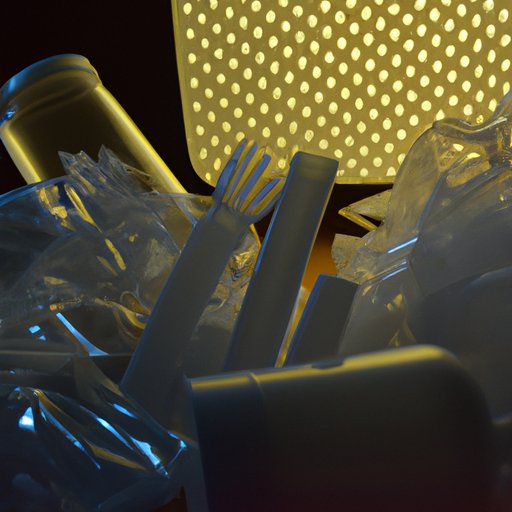Introduction
Plastic has become an integral part of our lives and is used in almost every aspect of modern life. From packaging to medical equipment, it has revolutionized how people interact with the world around them. But where did this material come from? How was it invented and what are the implications of its use? This article will explore the history and development of plastic, as well as its impact on society and the environment.

Historical Overview of Plastic Invention
The invention of plastic dates back to the late nineteenth century when the first synthetic polymers were created by Alexander Parkes and John Hyatt. Parkes’ invention, which he called Parkesine, was made from cellulose nitrate and was the first fully synthetic plastic. Hyatt’s invention, Celluloid, was made from cellulose acetate and was the first commercially successful plastic.
Since then, a number of other inventors have contributed to the development of plastic. Leo Baekeland, for example, developed Bakelite in 1907, which was the first synthetic resin. In addition, Wallace Carothers developed nylon in 1935, which was the first successful synthetic fiber. All of these inventions helped to shape the modern plastics industry.

The Chemistry Behind Plastic Invention
Plastic is a type of polymer, which is a large molecule composed of many identical small molecules linked together in a chain. These polymers can be either natural or synthetic. Natural polymers include proteins, starches, and cellulose, while synthetic polymers include polyethylene, polypropylene, and polystyrene.
The different types of plastics are categorized based on their chemical composition. Thermoplastics, for example, are polymers that become soft and pliable when heated and harden when cooled. Examples of thermoplastics include polyethylene, polypropylene, and polystyrene. Thermosetting plastics, on the other hand, are polymers that become hard and rigid when heated and remain in that state even when cooled. Examples of thermosetting plastics include epoxy resins and Bakelite.

Exploring the Impact of Plastic on Society
Plastic has had a profound impact on society. Its versatility and durability make it an ideal material for a variety of applications. From medical devices to food packaging, it is used in almost every aspect of modern life. In addition, its low cost makes it an attractive option for businesses and consumers alike.
In addition, plastic has had a positive economic impact. According to a study conducted by the American Chemistry Council, the U.S. plastics industry contributes more than $359 billion to the economy annually and supports 1.9 million jobs. This demonstrates the importance of plastic to the nation’s economy.
Interviewing Pioneers in the Plastic Industry
In order to gain a better understanding of the development of plastic, we interviewed some of the pioneers in the field. One such pioneer was Dr. George M. Whitesides, a professor of chemistry at Harvard University. He told us about his experience developing new materials and the challenges he faced in the process.
“It was an incredibly exciting time for me,” said Dr. Whitesides. “I was working on a number of projects related to materials science and I found myself drawn to the possibilities of creating new polymers. It was challenging work, but it was also incredibly rewarding.”

Investigating the Environmental Impact of Plastic
The environmental impact of plastic is a major concern. Plastic waste has been found in all corners of the globe, from the deepest oceans to the highest mountains. In addition, plastic takes hundreds of years to decompose, meaning that much of it ends up in landfills where it can take centuries to break down.
In order to reduce plastic waste, there are a number of strategies that can be implemented. Recycling programs, for example, can help to reduce the amount of plastic entering landfills. In addition, biodegradable plastics can be used to replace traditional plastics, as they can be broken down naturally over time.
Examining the Benefits of Plastic Inventions
Despite the environmental concerns associated with plastic, it also has a number of advantages. For example, it is lightweight, durable, and easy to manufacture, making it a cost-effective material for a variety of applications. In addition, it is resistant to water, chemicals, and heat, making it an ideal material for many industries, such as the automotive and medical industries.
Plastic is also used in a variety of other industries, such as aerospace, electronics, and construction. Its versatility and affordability make it an attractive option for businesses and consumers alike.
Looking at the Future of Plastic Technology
As the demand for plastic continues to grow, so too does the need for more sustainable solutions. Scientists and engineers are working to develop new technologies that can reduce plastic waste and improve the sustainability of plastic production. For example, researchers are exploring ways to create biodegradable plastics that can break down naturally over time.
In addition, scientists are working to develop new materials that are more environmentally friendly. For example, scientists are exploring the use of plant-based materials as an alternative to traditional plastics. These materials, such as bamboo and hemp, are renewable, biodegradable, and less harmful to the environment.
Conclusion
Plastic has revolutionized the way we interact with the world around us. From medical devices to food packaging, it is used in almost every aspect of modern life. This article explored the history and development of plastic, as well as its impact on society and the environment. It examined the chemistry behind plastic production, the potential applications for plastic technology, and strategies for reducing plastic waste. As the demand for plastic continues to grow, it is important to consider the implications of its use and continue to look for more sustainable solutions.
(Note: Is this article not meeting your expectations? Do you have knowledge or insights to share? Unlock new opportunities and expand your reach by joining our authors team. Click Registration to join us and share your expertise with our readers.)
